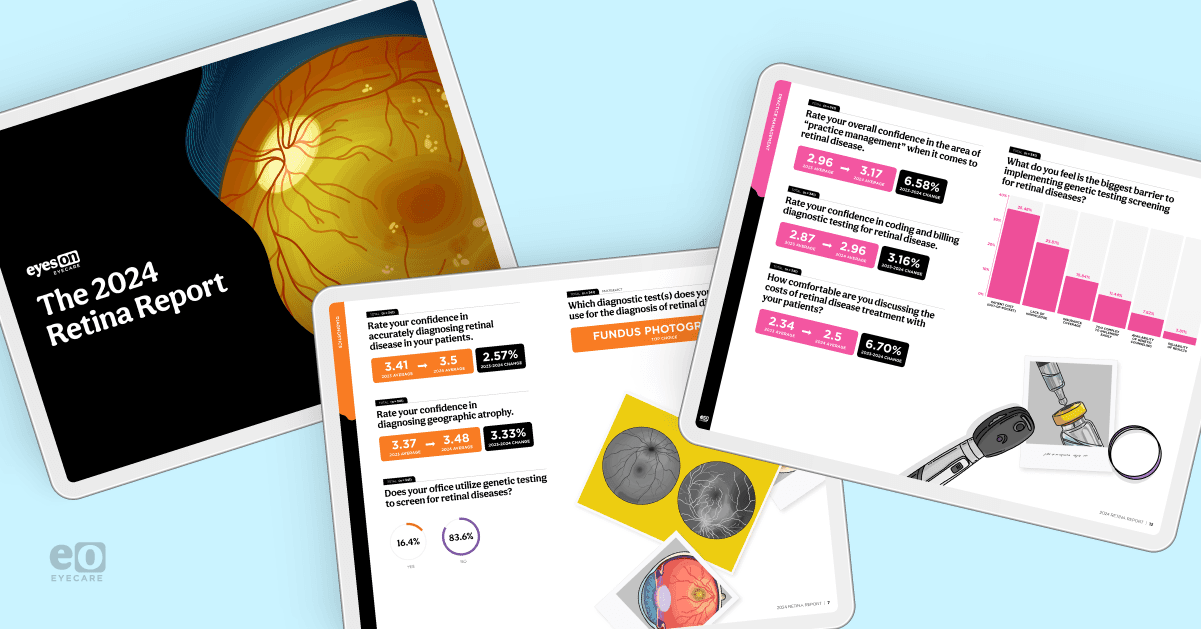In 2023, the World Health Organization (WHO) identified the five leading causes of blindness and vision impairment worldwide; retinal diseases—specifically age-related macular degeneration (AMD) and diabetic retinopathy—accounted for two of these causes, marking a combined 11.9 million affected.1
Furthermore, retinopathy of prematurity is a leading cause of vision impairment in children from middle-income countries. Meanwhile, in high-income countries, AMD is responsible for a higher proportion of adult vision impairment.1
With these data in mind, we set out to better understand the challenges and opportunities facing optometrists diagnosing and managing retinal disease in 2024. We wanted to learn how optometrists are administering retinal disease care and how they perceive the state of the retina space.
To see the results of this survey, download the report—or keep reading for a preview of our findings!
Download the 2024 Retina Report!

The 2024 Retina Report
Read about the highs and lows of diagnosing, treating, and managing retinal diseases, and how optometrists feel about the future of retinal disease care.

The 2024 Retina Report includes:
- Optometrists’ confidence in diagnosing retinal disease and the most common diagnostic tests used in practices
- Optometrists’ familiarity with new and upcoming retinal disease treatments
- Overall confidence in practice management, coding and billing, and patient communication in the area of retinal disease
- Desired education on retinal disease topics, including gene therapy, anti-vascular endothelial growth factor (VEGF) treatments, and others
- The biggest challenges and opportunities for innovation in retina care in 2024 and beyond
- And more!
Who’s who in the 2024 Retina Report
Our initial survey—conducted in August 2024 using Typeform—targeted respondents across diverse professional backgrounds, practice settings, and regions. We received 425 initial responses, which were filtered to 341 validated responses through a rigorous process of data cleaning and confirming respondent credibility.
Of this refined sample, 31.7% were practice owners while 68.3% were employed optometrists. The survey also revealed that 46% of verified respondents worked in private practice, 20.2% in corporate practice, and 19.6% in an ophthalmology or OD/MD practice.
What tests are optometrists using to diagnose retinal disease?
We asked optometrists to identify the brands of instruments their practice used for the following diagnostic tests:
- Optical coherence tomography (OCT)
- OCT-angiography (OCTA)
- Fundus autofluorescence (FA)
- Fundus photography
While a majority of respondents utilized three out of four of these tests, over 50% reported that their practice did not currently own one of these devices. Download the report to find out which one it was!
We also asked respondents to identify how frequently they utilized each of the following diagnostic tests in identifying geographic atrophy (GA):
- OCT
- OCTA
- FA
- Fundus photography
- Ophthalmoscopy
- Indocyanine green angiography (ICGA)
- Near-infrared reflectance (NIR) imaging
There were three tests that the majority of optometrists reported always performing:
To see the rest of the data—including which diagnostic tests respondents almost never use to diagnose GA, download the full report!
How comfortable are optometrists co-managing retinal disease?
While optometrists are moderately comfortable managing geographic atrophy, they’re far more comfortable co-managing GA with an ophthalmologist:
To get the rest of the data—including the statistics on how satisfied ODs are with their overall level of collaboration with other eyecare providers—download the full report!
Obstacles in co-managing retinal disease patients
However, there are still some challenges in co-managing retinal disease patients! The top one is, as expected, cost, followed by navigating insurance.
To see all ten top categories of challenges, download the full report!
Education and challenges
Optometrists are eagerly learning more about retinal disease diagnostics, treatment, and management each year, especially with the expanded availability of online education.
Additionally, our respondents are looking forward to innovations in treatment options and medications in 2024 and beyond, as each provides an exciting avenue for better patient care and collaboration between optometrists and ophthalmologists.
